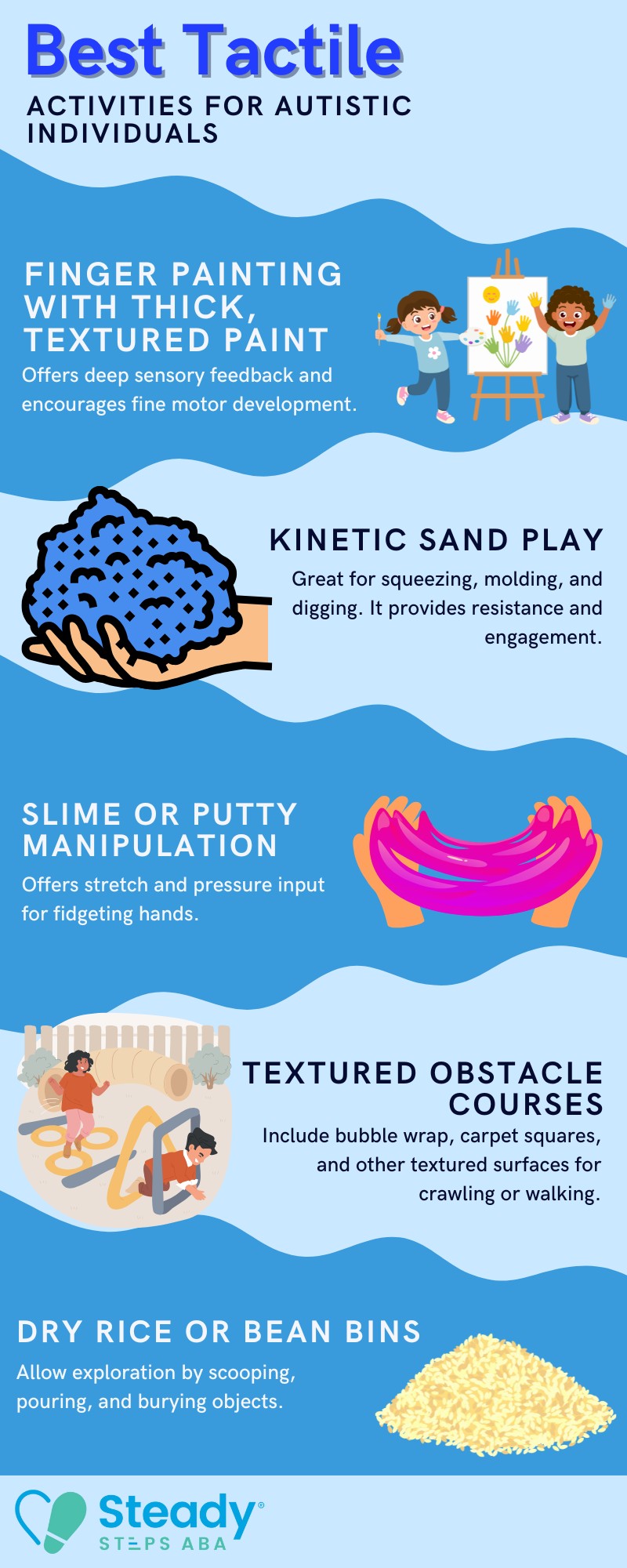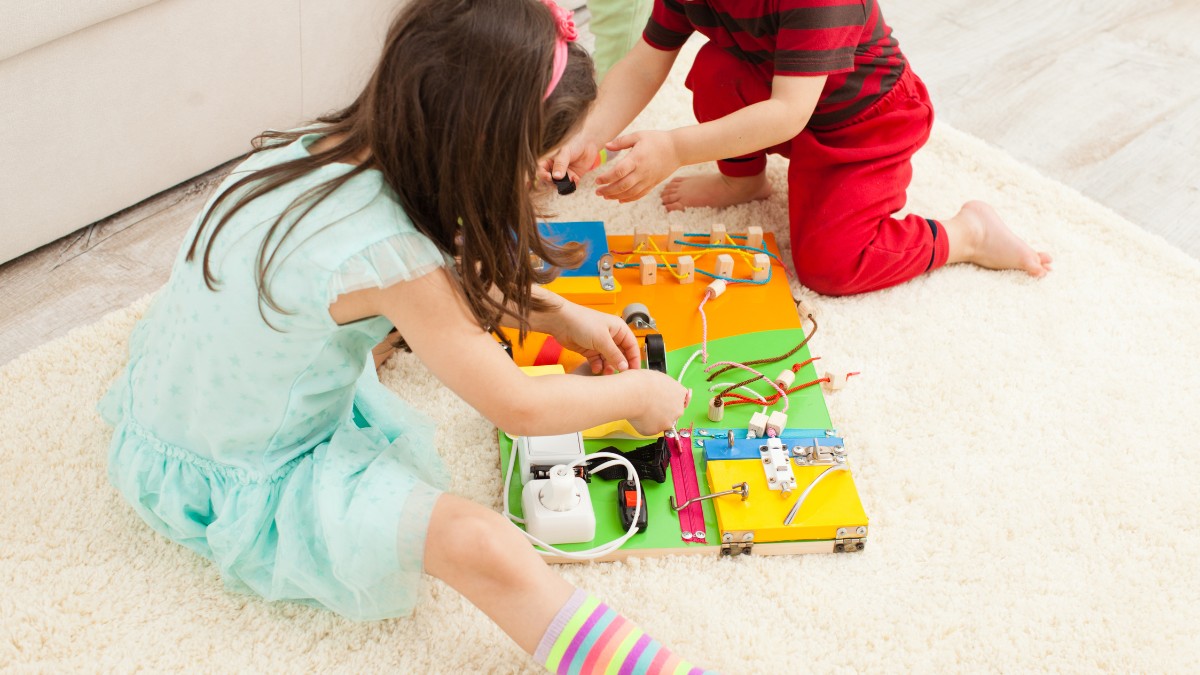Key Points:
- Tactile sensory activities can help regulate and develop sensory processing in both children and adults.
- Activities should be tailored to individual sensitivity levels, whether for sensory-seeking or sensory-avoidant behaviors.
- Engaging in tactile play supports emotional regulation, focus, and daily functioning, especially for individuals with autism or sensory processing challenges.
According to studies, up to 40% of autistic children experience some type of tactile sensitivity. Tactile sensitivity can significantly affect daily life, especially for individuals with autism or sensory processing disorder.
Tactile sensory activities offer a powerful way to address both sensory-seeking and sensory-avoidant behaviors. Whether you’re working with a child who craves intense textures or an adult who avoids tags on clothes, structured tactile input can make a difference.
Understanding and incorporating tactile sensitivity activities into everyday routines helps individuals process touch-related sensations more effectively. These activities can improve focus, reduce stress, and support fine motor development. From simple household items to specialized tools, there’s a wide range of tactile experiences that support self-regulation and engagement.

What are Tactile Sensitivity Activities?
Tactile sensitivity activities are structured exercises or play-based tasks designed to help individuals process touch-related sensations in a healthy and organized way.
These activities stimulate the skin through textures, temperatures, vibrations, and pressure. For individuals with sensory integration challenges, such as those on the autism spectrum, these activities can provide calming input or stimulate under-responsive systems. Tactile activities are not one-size-fits-all; they should be chosen based on whether the person seeks or avoids touch stimuli.
Why are Tactile Activities Important for Sensory Regulation?
Tactile input is one of the earliest senses to develop and plays a vital role in emotional development, social connection, and body awareness. When this system is dysregulated, it can affect how a person feels about their environment and themselves.
For example, a child with tactile defensiveness may resist brushing their teeth or wearing certain fabrics. An adult with sensory-seeking tendencies might constantly touch objects or fidget. Tactile activities provide a structured way to introduce, desensitize, or fulfill these sensory needs.
How Do You Choose the Right Tactile Activity?
Choosing the right activity requires observation and sometimes trial and error. Look for signs of sensory-seeking (e.g., constantly touching everything, chewing on items) or sensory-avoidance (e.g., gagging at textures, refusing to walk barefoot).
Once you understand the pattern, tailor tactile activities to match their threshold. Here’s a list of ideas separated by need type to get you started:

How Often Should Tactile Activities Be Used?
Tactile activities should be used consistently throughout the day, ideally during natural breaks or transitions such as before school, between tasks, or during calming routines. For children and adults with sensory processing challenges, incorporating brief tactile input multiple times daily can help support emotional regulation, focus, and comfort.
The frequency and intensity of tactile activities should always be tailored to the individual. Some people may benefit from frequent input every hour, while others might need just a few sessions per day. Observing how a person responds—whether they seem calmer, more alert, or overstimulated—can help guide adjustments. In a similar way, other sensory-based interventions can play a powerful role in promoting regulation and growth—explored further in our article, “How Music Therapy Helps Children with Autism Thrive.”
Can Adults Benefit from Tactile Sensory Activities?
Absolutely. Adults with tactile processing challenges often go undiagnosed or untreated. Many may not realize that their discomfort with textures, tags, or fabrics is rooted in sensory processing difficulties.
Adults may also benefit from sensory breaks, especially in high-stress environments. Engaging in tactile activities can support emotional regulation, reduce anxiety, and improve daily functioning. Activities should be age-appropriate and may include:
1. Clay Sculpting or Pottery
Hands-on activities like clay sculpting and pottery provide deep tactile input, enhance focus, and support stress relief through creative, repetitive movement.
2. Gardening or Digging Soil
Working with soil delivers rich, grounding tactile sensations while also connecting adults to nature and calming the nervous system.
3. Knitting, Crocheting, or Textile Crafts
These crafts combine fine motor engagement with repetitive texture exposure, promoting sensory regulation, concentration, and emotional calm in a soothing, rhythmic format.
4. DIY Spa Routines (Scrubs, Lotions, Facial Rollers)
Home spa activities like exfoliating scrubs or lotion application deliver calming tactile input and offer moments of intentional self-care and sensory relaxation.
5. Fidget Jewelry or Textured Accessories
Discreet and portable, these tools offer continuous tactile input throughout the day, supporting focus and emotional regulation in adults with sensory sensitivities.
When Should You Seek Professional Support?
If tactile defensiveness or seeking behaviors disrupt daily functioning—like school participation, hygiene routines, or relationships—it’s time to involve professionals. Occupational therapists (OTs) and ABA providers can assess sensory needs and create personalized strategies.
A comprehensive sensory profile helps determine the exact nature of the tactile processing challenge and informs a plan that balances exposure and support. This is especially important for children on the autism spectrum, where sensory issues often overlap with communication and behavioral concerns. Because similar sensitivities can also occur with auditory input, you may find it helpful to explore our article Understanding the Impact of Sound Sensitivity in Autism.
Foster Growth and Development With ABA Therapy
Tactile processing is just one aspect of how individuals experience the world—and it often interconnects with behavior, communication, and learning. Applied Behavior Analysis (ABA) therapy incorporates sensory strategies to support emotional regulation, transitions, and task completion.
At Steady Steps ABA, our team understands how sensory issues affect real-life situations. Whether you’re parenting a child with autism or seeking adult services, our ABA therapy programs are built to address each individual’s unique sensory profile.
We provide ABA therapy in Maryland, helping families navigate tactile sensitivities, behavioral challenges, and developmental goals through personalized plans rooted in evidence-based practices.
Get in touch with us today to learn how we can support your family’s journey with sensory regulation and lasting growth.






